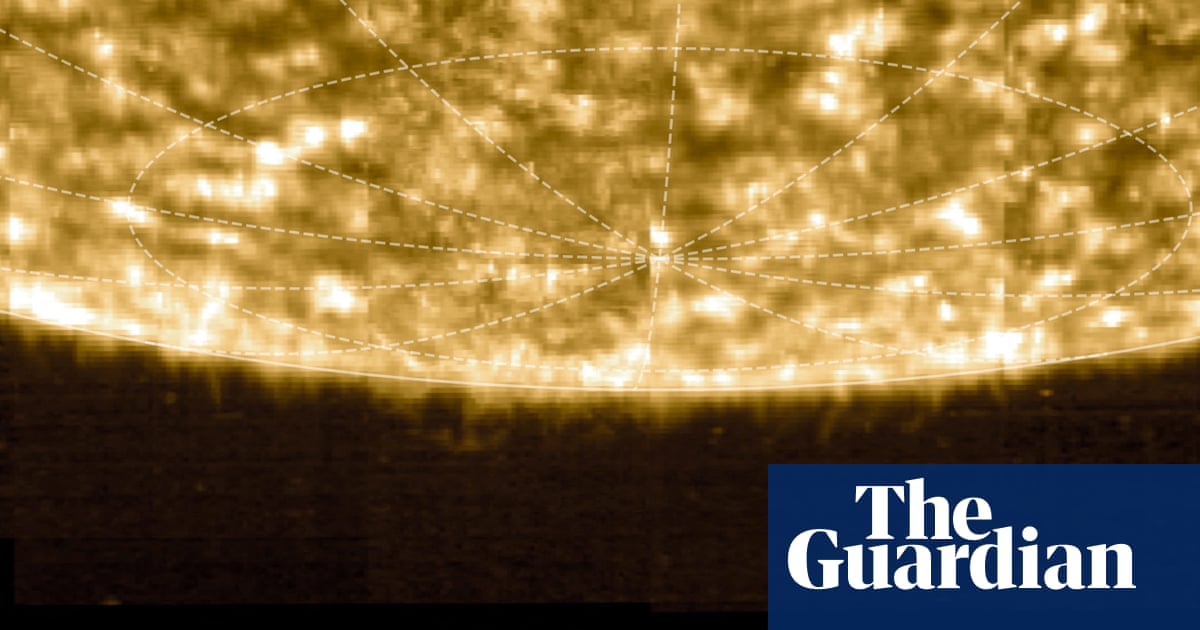The sun’s uncharted south pole has been revealed for the first time in striking images beamed back from the Solar Orbiter spacecraft.
The joint EuropeanSpaceAgency (ESA) and Nasa mission swooped below the planetary plane and, for the first time, captured the sun’s mysterious polar regions. The groundbreaking observations also mapped a chaotic patchwork of magnetic activity at the sun’s pole that scientists say is key to understanding how the sun’s field flips roughly every 11 years.
“Today we reveal humankind’s first-ever views of the sun’s pole,” said Prof Carole Mundell, the ESA’s director of science. “The sun is our nearest star, giver of life and potential disruptor of modern space and ground power systems, so it is imperative that we understand how it works and learn to predict its behaviour. These new unique views from our Solar Orbiter mission are the beginning of a new era of solar science.”
The $1.3bn (£1.1bn) mission,which launched in 2020, shows the sun’s south pole as recorded mid-March, when the craft had dipped to an angle of 15° below the solar equator to perform the mission’s first high-angle observations. While the Earth – like a bar magnet – has a clear north and south, the sun’s magnetism flips roughly every 11 years. The sun is currently at a solar maximum, the period when it builds up to a polarity flip, in which the south pole will become magnetic north and when sun spots and solar flares are most active.
Solar Orbiter’s first magnetic field measurements reveal a fragmented mosaic of both north and south polarity at the base of the sun. This patchwork of north and south had been predicted in computer models, but had never been confirmed in observations. Scientists say that tracking the dramatic changes in the sun’s polar magnetic fields will be crucial to improving forecasting of the solar cycle.
“We didn’t know what exactly to expect from these first observations – the sun’s poles are literally terra incognita,” said Prof Sami Solanki, who leads the instrument mapping the magnetic field and is based at the Max Planck Institute for Solar System Research (MPS) in Germany.
The sun’s magnetic cycle occurs because it does not rotate as a solid object, with its equator spinning faster (every 26 days) than its poles (33 days). This stretches and twists magnetic field lines around the sun until they become so unstable that north and south eventually flip.
Prof Lucie Green, of UCL’s Mullard Space Science Laboratory, who has worked on the mission since 2005, said: “Everything in the atmosphere of the sun and whole character of the sun is generated by its magnetic field and how that changes over time. It goes from being a fairly quiet star to being really active and dynamic star with explosions in the atmosphere. Although the models predicted that the field should be mixed up, it’s something else to actually see it.”
In five or six years, the sun will reach its next solar minimum, during which its magnetic field is at its most orderly and the sun has the lowest levels of activity. Current models and predictions of the 11-year solar cycle fall short of being able to predict exactly when and how powerfully the sun will reach its most active state.
The only previous mission to have flown above the sun’s poles was Nasa’s Ulysses probe, launched in 1990, but while it took measurements of the sun’s magnetic field and solar wind, it did not have a camera. Solar Orbiter will continue to orbit around the Sun at a 17° tilt angle until 24 December 2026, when its next flight past Venus will tilt its orbit to 24° and in 2029, the spacecraft will rise to an angle of 33° above the planetary plane.
